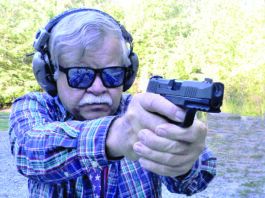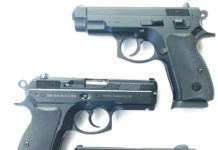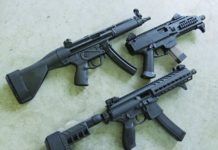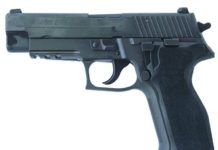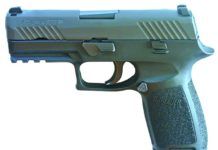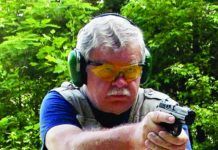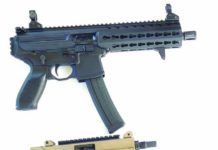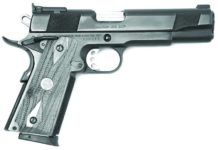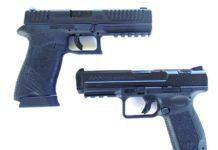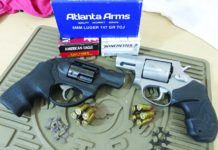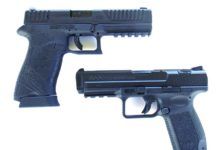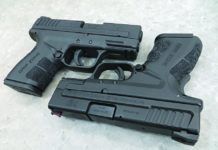American-Made 9mms: Ruger, Springfield, and Honor Defense
When it comes to 9mm carry pistols, there are several characteristics that immediately come to mind. Polymer frame, striker fired, wide grips, and high capacity. Recently we found three, or should we say three and a half pistols, that didn't quite fit that description.
The first was Ruger's $579 American Compact model 8633 that featured thumb-operated safeties on both sides.
Next were products from Honor Defense, one of the newer makers on the market. The $499 Honor Guard HG9CLE is a single-stack double-action-only pistol. The LE suffix stands for law enforcement. This gun was a variation on the original Honor Defense pistol, but it lacks a Picatinny accessory rail to favor inside-the-waistband carry for undercover work. Our 3.8-inch-long-barreled Compact LE pistol arrived with a second top end ($250, sold separately) that housed a 3.2-inch-long barrel. The shared receiver boasted unique grip contours, and both top ends utilized the same guide rod and recoil spring.
Third was the $1220 Springfield Armory 1911 EMP 4-inch Conceal Carry Contour pistol, which arrived with three 9-round magazines. The EMP operates with a single-action trigger, and this might have been our first test wherein a single-stack 1911 pistol packed more rounds than its polymer-framed competitors. Its descriptive name referred to the gun's backstrap, which has been sliced diagonally, making the rear of the grip about of an inch shorter than if it were continued in a straight line to the heel of the magazine well. This made the pistol more concealable, specifically when holstered with a butt forward (or muzzle back) cant.
Our test sessions began and ended on the reactive targets located on Steel Alley at American Shooting Centers in Houston. Accuracy data was collected from a distance of 15 yards with the guns supported by a Caldwell Matrix rest. Our choice of test ammunition consisted of Browning's new 147-grain BXP X-point jacketed hollowpoints and three different rounds from Black Hills Ammunition of Rapid City, South Dakota. They were the 115-grain JHP EXPs that were designed for maximum performance in guns not rated for +P ammunition, a 124-grain JHP +P choice, and a new subsonic round, the 125-grain non-expanding HoneyBadger ammunition. We tracked the velocity of each combination using an Oehler 35P (printing) chronograph.
All three guns were recent releases, so we really didn't know what to expect. As always our goal was to reveal reliability and accuracy as well as handling characteristics. Would we find versatility or would the accuracy of each gun be limited to a single bullet weight? Our job was to deliver to point of aim every time we pulled the trigger. Would any of these guns make that job easier than the others? Here is what we learned.
Compact 9mms: Canik, CZ-USA, and Arex
In this issue, we test four compact handguns chambered for the 9mm Luger cartridge, the most popular defensive cartridge, according to sales figures compiled by the Bureau of Alcohol, Tobacco, Firearms, and Explosives. The 9mm offers real power in a compact high-pressure cartridge. The handguns that chamber the cartridge are often very reliable, and modern loads have a lot going for them. A service-size pistol is too large for many people to carry concealed and are unwieldy in home-defense situations for others as well. As a result, the ideal 9mm handgun would seem to be a compact version of the service pistol. These are service handguns with a shorter grip and slide that makes the piece easier to carry and for many of us, easier to handle under pressure. But the short slide radius may make precision shooting more difficult.
Some prefer a decocker on their double-action-first-shot handguns, but there is a smaller, but dedicated, group that prefers the selective-double-action type and others perhaps would like to have both. These shooters do not care for the Glock or a double-action-only system and often choose a CZ or SIG-type handgun. We fired off a variety of compact 9mm handguns and came to a conclusion, based on the opinion of our testers, as to which handgun is the best suited for most shooters, with the emphasis on the beginning, but still competent, shooter. Some of the choices are subjective, but the objective components — accuracy and reliability — are most important. If a compact 9mm fits your needs for self defense, one of these handguns will be a good choice, and one will be the best choice, we believe.
Forward-Mounted-Mag 9mm Pistols from SIG, Zenith, & CZ
In the October 2016 issue, we tested three high-capacity 9mm Luger pistols and found them somewhat lacking in defensive scenarios, though we did enjoy shooting one, the MPA Defender, which was sized more like a regular pistol than the carbine-like SIG MPX and which functioned better than an Uzi Mini Pro. But there are an increasing number of pistols that, save for a couple of features, function more like Short-Barreled Rifles (SBRs), which are controlled by much more stringent regulations under the National Firearms Act and are vastly more expensive and hard to get. The SIG MPX-PSB, for example, is similar to the unit we tested last October except it comes with a Stabilizing Brace, thus the "SB" in the name, compared to the "P" designation we initially tested.
This round, we found products more alike in size to the SIG Sauer MPX-PSB, namely, the CZ Scorpion EVO 3 S1 and the Zenith Firearms MKE Z-5RS with SB Brace. The Zenith and SIG came with a stabilizing brace, while the CZ did not, but it could be purchased separately. The SIG, CZ, and Zenith are tactical looking firearms because they all have a military ancestry that is especially noticeable due to the magazine mounted in front of the trigger guard and not in the grip. The three pistols tested are all semi-automatic, require two hands to shoot with any degree of accuracy, use high-round-capacity magazines compared to typical full-size handguns, and have the ability to be fired with a stabilizing brace. These pistols also represent three different operating mechanisms: the SIG uses a short push-rod gas system; the CZ a simple blowback system, and the Zenith a delayed roller-block mechanism. During firing, we noticed big differences in the mechanisms in both manual operation and cycling when fired, which we will get into. The ergonomics and controls differed as well, yet we found our ramp-up time transitioning between handguns to be short.
Initially, there is an awkwardness shooting these pistols because they feel like an SBR yet have no stock for a steady aim, and they are too heavy to fire in a Weaver, Isosceles, or hybrid stance with a two-hand hold like a typical handgun. We believe adequate range time and proper training is needed to master these pistols.
Most important, we wondered if, out of the box, these similar, yet different, pistols would work as home-defense choices. In our opinion, the upside of these three pistols is that they offer high magazine capacities, decent accuracy, and a lot of shooting fun. Yes, these pistols can make empty brass very quickly. On the downside is cost. Yes, you can purchase a lot less gun for a lot less money and achieve the same self-defense goal as what this trio delivers, we believe. Still, we looked forward to seeing what each firearm could do at the range.
2016 Guns & Gear Top Picks
Toward the end of each year, I survey the work R.K. Campbell, Roger Eckstine, Austin Miller, Robert Sadowski, David Tannahill, Tracey Taylor, John Taylor, Rafael Urista, and Ralph Winingham have done in Gun Tests, with an eye toward selecting guns, accessories, and ammunition the magazine's testers have endorsed. From these evaluations I pick the best from a full year's worth of tests and distill recommendations for readers, who often use them as shopping guides. These choices are a mixture of our original tests and other information I've compiled during the year. After we roll high-rated test products into long-term testing, I keep tabs on how those guns do, and if the firearms and accessories continue performing well, then I have confidence including them in this wrap-up.
Bigger 9mms Handguns: SIG, Arsenal, and Beretta Go At It
As noted earlier in this issue, 9mm auto-loading pistols are among the most commonly purchased firearms in America for pleasure, competition, and defense. These guns are offered in many styles and price points, ranging from a few hundred to several thousands of dollars. While the handguns in this comparison are not top-end, highly customized pistols costing thousands of dollars, they are generally marketed as being well above average quality in fit, features, and capabilities.
In this comparison, we test five pistols, three of which were built by SIG Sauer, one by Beretta, and one newcomer from Arsenal. The SIGs tested are the classic P210, the P226 MK25 used by the U.S. Navy SEALS, and the relatively new P320. The Beretta tested is the recently updated M9A3. The fifth gun is the new Strike One from Arsenal.
For our evaluation, we used three different 9mm loads from three different manufacturers in two different weights and two different bullet styles. As always, the guns in question were shot by multiple testers (this time three men and three women) of different backgrounds.
We did our accuracy testing at Boyert Shooting Centers, an indoor range in Houston, and followed the standard accuracy protocol of collecting five 5-round groups at 25 yards from a rest for each pistol/ammunition combination. For this test, we also performed a speed drill. The speed drill involved starting from a low-ready position, shooting twice to the chest and once to the head of a silhouette paper target. This test was performed at 7 yards by one experienced tester with large hands. The speed test was performed after the familiarization shooting, but before the accuracy testing. The tester was given only one opportunity to perform the test. As these pistols are supposed to be superior to the average offering, our team expected above-average results and graded accordingly. Though all five pistols turned in good results and had their fans, the testing yielded one clear surprise winner.
Modern 9mm Subcompacts: CZ-USA, Glock, Steyr Compete
It goes without saying that compact and subcompact pistols chambered in 9mm Luger are a highly desirable form of personal protection. The 9mm offers acceptable ballistics without harsh recoil, and 9mm pistols from a quality maker are famously reliable. Also, 9mm compact pistols are often based on service-size handguns in the best renditions. The action and spring rates, and making certain slide travel and barrel tilt are compatible with the compact size, is important engineering. When done correctly, compact pistols are as reliable for practical use as any full-size pistol. Accordingly, our readers often ask us for reviews of certain pistols they've come across and may want to buy, if testing proves them to be worthwhile. So, this time, we line up a set of reader requests to go head to head at the range.
The first contestant was CZ-USA's 2075 RAMI B 91750 9mm Luger, $530. The RAMI is similar to the original CZ 75 but represents considerable engineering changes to accommodate the short slide and frame. The CZ 75 slide rides in the frame inside the frame rails, a design feature that some feel adds to the pistol's accuracy. This engineering lowers the bore axis as well, resulting in less muzzle flip compared to most double-action first-shot pistols. A tradeoff is that the slide is sometimes difficult to grasp and rack.
Next up was the Glock G43 Limited Edition ProGlo TALO Edition UI4350501, available for $489 from Slickguns.com. TALO is a wholesale buying cooperative that was started in 1965 by fishing and hunting wholesalers in Texas, Arkansas, Louisiana, Oklahoma. TALO commissions limited editions of firearms from Smith & Wesson, Colt, Glock, Ruger, and North American Arms and distributes them to stocking sporting goods dealers across the US. Shooters who want one of these special editions will need to contact their local dealer and ask him to order the special edition firearm from a TALO wholesaler. TALO firearms are often specially designed products with top-end accessories. An example came in 2006 with the Ruger John Wayne Vaquero. The first edition of 3500 units was featured as an American Rifleman's Magazine editor's pick. On this Glock 43, the pistol's slide is standard save for the sights, which are made by AmeriGlo and feature a brilliant orange post around a white-insert tritium front. The rear sight features a U-notch for rapid target engagement. The rear face of the rear sight is serrated to reduce glare.
The Steyr S9-A1 9mm Luger, $483 at BudsGunShop.com, isn't particularly more difficult to conceal then the RAMI, but it is not a pocket gun as the Glock 43 is. The Steyr S9A1 is a double-action-only handgun with a trigger action more Glock like than anything. The Steyr barely came in as the least expensive pistol tested. This is the largest pistol tested, but it is lighter than the RAMI due to the Steyr's polymer frame. More effort is needed to cock this pistol due to a combination of the slide design and a heavy recoil spring.
In accuracy testing from the bench at 15 yards, we used three loads. The Speer Gold Dot 124-grain +P Short Barrel hollowpoint load cost us $23/20 rounds at MidwayUSA.com. The Black Hills Ammunition 115-grain EXP ran us $14.57/20 rounds, also from MidwayUSA.com, and Winchester's 115-grain USA Forged steel shellcase FMJs came to us from Cabelas.com (prior to the buyout by Bass Pro) and cost $36 for 150 rounds. Following is how the pistols fired those rounds, along with comments by our hands-on testers.
9mm Pistols: Uzi Mini Pro, MPA Defender, and SIG Sauer MPX-P
The civilian-available semi-auto versions of what began as expensive SBR's (short-barrel rifles) or true submachine guns are advertised as having good accuracy and reliability while offering a more compact package than a rifle and higher round counts than most handguns. For the task of guarding the castle, we've been around the block a time or two, and have suitable choices for nearly anyone — great pistols, rifles, and shotguns. For this test, we had to suspend any preconceived notions of what we might prefer for home defense and test these firearms based on their own merits. Those merits, we found, are few. If you are shooting for fun and simply making brass, anything that goes bang is suitable. We'll get into the reasons for these judgments, but we like to be clear up front. The SIG Sauer MPX-P is one expensive means of not accomplishing much. The Uzi Pro pistol has drawbacks that made shooting downright frustrating. The MasterPiece Arms Defender proved to be the best of the three and has merit in a defensive situation, within certain narrow parameters. We arrived at this decision by using personal-defense criteria as the overriding factor in providing Buy/Don't Buy advice to our loyal readers. So, in more detail, here are our reasons for making these assessments. Our 9mm Luger ammunition for this test included a 158-grain lead round nose choice from Tomkatammo.com ($18/50 rounds). We also used Black Hills Ammunition 124-grain jacketed hollow points from VenturaMunitions.com ($14/20), a Black Hills Ammunition 115-grain EXP, an Extra Power load not quite in +P territory, also available from VenturaMunitions.com, ($17/20), and a SIG Sauer 115-grain full-metal-jacket load from Cabelas.com ($28/50). Others included the SIG Sauer 124-grain V Crown jacketed hollow point from Luckygunner.com ($16.75/20), and the Hornady American Gunner 124-grain XTP +P from MidwayUSA.com ($14.79/20). We used the Tomkat 158-grain, the Black Hills 124-grain JHP, and the SIG 115-grain FMJ load in benchrest accuracy testing.
More Laments for Custom Guns
Like Grant said in last month's letters section, I, too, lament the passing of the pride of custom-gun ownership and the common look of the Ubiquitous Black Gun. But, as was said, black guns are cheap and proven reliable. Also, I cannot justify carrying a nice custom pistol on the off chance that I might have to use it. In that case, I would have to surrender it to the police, and then it would be months at a minimum to maybe get it back by jumping through their hoops.
Yes, I would rather carry a "Rolex"-quality sidearm, but I often think that if I had to give up my Valtro, I'd don't know what I'd do.
A black gun I can give up with no emotion, and go home and get another one. I always enjoy the magazine, from the editorial remarks to the last page. — Dave
Century Versus Diamondback: Affordable 9mms Butt Heads
The high-capacity 9mm handgun continues to be a popular personal-defense choice, for good reason. Many of the finest handguns in the world are chambered for the 9mm Luger cartridge and nothing else. In a handgun of 30 ounces or so, loaded recoil is light to manageable. Practical accuracy may be outstanding. A magazine capacity of 15 rounds or more is reassuring and gives a good reserve of ammunition. With these considerations in mind, we tested two modern economy-grade 9mm handguns whose performance was acceptable, especially considering the price, though our shooters found we liked one pistol better.
These two handguns are large for concealed carry, but they are light enough and may be concealed with enough effort and an intelligent holster choice. Certainly, they can be employed in the home, where overall size is less of an issue. Those firing and using compact handguns may not realize how easy bigger handguns are to use well compared to a pocket model.
One such larger handgun that is affordable to boot is the Century Arms TP9SA, which is listed in the company's catalog as SKU HG3277-N. A similar desert tan model is HG3277D-N. We found one selling for $346 atBudsgunshop.comand another one on sale at Cabela's for just under $300. This handgun is manufactured by Samsun Yurt Savunma, a Turkish gun maker, and imported by Century Arms of Delray Beach, Florida. The TP9SA and many of its accessories are marked "Canik," for the Canik 55 division of the manufacturer. So, to be plain about it, the Century Arms TP9SA is a Canik 55 9mm pistol, similar in outline to the Smith & Wesson SW99 and Walther P99. There are enough differences between the Canik and the Walther pistol to say the former is not a clone of the latter, but the Century import is obviously similar to a comparable Walther, being a service-size 9mm with a polymer frame and mid-length slide and a 4.25-inch barrel. Our second test gun was the Diamondback Firearms DB FS Nine DB9FS 9mm Luger, which lists for $483, but which we found at Budsgunshop.com selling for $265. Founded in 2009, Diamondback Firearms is based in Cocoa, Florida.
The Diamondback DB9FS is a striker-fired polymer-frame pistol that in general outline resembles the Glock 17. Our shooters noted that the pistol feels different than a Glock, and the overall configuration is markedly different than the Glock. Here's more about these two affordable 9mm pistols.
9mm Luger Snubnose Revolvers: Ruger LCR versus Taurus 905
The 9mm is the most popular handgun cartridge in the world, in use with most military forces and LE agencies; in fact the FBI announced in 2014 that it is switching back to the 9mm after having used the 40 S&W since 1997. When we think snubnose revolvers, we typically think 38 Special, but since the mid-20th century, revolver manufacturers have been building short-barreled wheelguns chambered for 9mm semi-automatic pistol ammunition. In the past we tested two such 9mm Luger chamberings, an S&W Model 940 (C+) and Charter Arms Pitbull (A-). We noted then that 9mm compact semi-automatic pistols have an edge over 38 Special revolvers due to the semi-automatic's higher round capacity, but in the revolver, the playing field between 38 Special and 9mm Luger is leveled, as far as round counts go.
Now, ballistic technology has made the once underperforming 9mm better. We have done a number of tests comparing 9mm and 38 Special ammunition from short-barrel handguns, and, generally speaking, the 38 Special runs bullets with weights from 110 to 158 grains at muzzle velocities of 900 fps to 1000 fps. The typical 9mm uses bullet weights from 115 to 147 grains at speeds of 910 fps to 1100 fps. So the 9mm has a slight performance advantage over the 38 Special. A bigger nod goes to the availability and affordability of 9mm ammo, which can be found nearly anywhere in the world, and which domestically costs about 17 cents a round compared to 25 cents a round for 38 Special.
There are other reasons to look at 9mms in wheelguns. We feel the ability to swap ammo between our semi-auto and our revolver makes sense, with only one type of cartridge to purchase. New shooters usually find revolvers to be less complicated to operate, so if your home-defense backup isn't familiar with semi-autos, you can still partner a high-cap 9mm semi-auto with a low-cap 9mm wheelgun pretty easily.
Though some testers groaned when they saw the 9mm revolvers in this test, saying they were as unnatural as three-wheel motorcycles, they put their prejudices aside and found these revolvers performed well at the range. The Ruger LCR Model 5456 9mm Luger debuted in 2014, and the Taurus 905 has been around since 2003. Unlike the Charter Arms Pitbull (which does not use moon clips, but instead employs a retention spring built into the ejector that fits under the 9mm cartridge's rim), the LCR 9mm and the 905, like the S&W Model 940, use five-shot moon clips. Moon clips have been the standard convention when chambering semi-automatic cartridges in revolvers since 1917, when 45 ACP was chambered in S&W and Colt's large-frame revolvers. Moon clips mean the revolver is fast to reload — nearly as fast as a magazine change in semi-auto. But, as we have found in the past, carrying a spare moon clip in one's pocket can lead to bent clips, making them inoperable. Not that this a show stopper, just an attribute of moon clips in general. So don't put a moon clip in your rear pants pocket and sit down. In fact we loaded both the Ruger and Taurus moon clips provided with the test guns and dropped them onto a concrete floor from waist height to see if the cartridges would fall out or the clips bend. A cartridge from each clip popped out after the drop, but there was no sign of bending. Another cost we looked at was how much moon clips go for.Brownells.comlists three moon clips for $12.99 (#780-001-371WB), less than one semi-auto magazine. The moon clips from Taurus and Ruger were not compatible with the other manufacturer's revolver. We should note that single cartridges can be loaded into the chambers of the Ruger and Taurus wheelguns and fired safely, since the 9mm case headspaces on a step in the chambers. In that case however, extraction without a moonclip requires each case be pushed out with a pencil, pen, or similar skinny object.
Century Versus Diamondback: Affordable 9mms Butt Heads
The high-capacity 9mm handgun continues to be a popular personal-defense choice, for good reason. Many of the finest handguns in the world are chambered for the 9mm Luger cartridge and nothing else. In a handgun of 30 ounces or so, loaded recoil is light to manageable. Practical accuracy may be outstanding. A magazine capacity of 15 rounds or more is reassuring and gives a good reserve of ammunition. With these considerations in mind, we tested two modern economy-grade 9mm handguns whose performance was acceptable, especially considering the price, though our shooters found we liked one pistol better.
These two handguns are large for concealed carry, but they are light enough and may be concealed with enough effort and an intelligent holster choice. Certainly, they can be employed in the home, where overall size is less of an issue. Those firing and using compact handguns may not realize how easy bigger handguns are to use well compared to a pocket model.
One such larger handgun that is affordable to boot is the Century Arms TP9SA, which is listed in the company's catalog as SKU HG3277-N. A similar desert tan model is HG3277D-N. We found one selling for $346 atBudsgunshop.comand another one on sale at Cabela's for just under $300. This handgun is manufactured by Samsun Yurt Savunma, a Turkish gun maker, and imported by Century Arms of Delray Beach, Florida. The TP9SA and many of its accessories are marked "Canik," for the Canik 55 division of the manufacturer. So, to be plain about it, the Century Arms TP9SA is a Canik 55 9mm pistol, similar in outline to the Smith & Wesson SW99 and Walther P99. There are enough differences between the Canik and the Walther pistol to say the former is not a clone of the latter, but the Century import is obviously similar to a comparable Walther, being a service-size 9mm with a polymer frame and mid-length slide and a 4.25-inch barrel. Our second test gun was the Diamondback Firearms DB FS Nine DB9FS 9mm Luger, which lists for $483, but which we found at Budsgunshop.com selling for $265. Founded in 2009, Diamondback Firearms is based in Cocoa, Florida.
The Diamondback DB9FS is a striker-fired polymer-frame pistol that in general outline resembles the Glock 17. Our shooters noted that the pistol feels different than a Glock, and the overall configuration is markedly different than the Glock. Here's more about these two affordable 9mm pistols.
9mm and 45 ACP XD Mod.2 Subcompacts Go Head to Head
The compromise that shooters have to deal with in choosing a concealed-carry sidearm is this: A smaller pistol that is easier to conceal is usually more difficult to operate and shoot; and a larger pistol that is easier to operate and shoot is more difficult to conceal. A line of guns retailers have told us are popular carry pieces are the newest Springfield Armory XD variants, the XD Mod.2 series.
They are supposedly redesigned XD subcompacts that have better ergonomics, more useful sights, and slimmer profiles. If you are looking for a concealed-carry handgun that offers a super-slim profile, less weight, and better concealability, we suggest you stick with a single-stack pistol like Springfield's XD-S 3.3, which we reviewed in February 2015 (Grade A). On the other hand, if you want a pistol that is still concealed-carry friendly but has nearly double the magazine capacity with the feel of a full-size pistol, the Mod.2 pistols are supposed to fill that ticket. So we tested the two most-popular chamberings of the Mod.2 pistols in 9mm Luger and 45 ACP to see what all the fuss is about. The question that needed to be answered is, are these new guns so good that we would recommend you considering switching from your favorite carry piece? That is a super-high barrier for any handgun to scale, and, ultimately, each concealed-carrier has to make the decision to try them on his or her own.
The trend these days with law enforcement is to move to the 9mm cartridge, and many agencies we are acquainted with are using 147-grain ammo. So we selected 147-grain cartridges from Atlanta Arms as well as 115-grain rounds from Black Hills and Hornady. For the 45 ACP, we stuck with the most popular bullet-weight choice, 230 grains, selecting FMJs from Perfecta and Federal and hollowpoints from Atlanta Arms. We had no experience with Perfecta 45 ACP ammo, but found it at a big-box store and thought we'd try it.
We fired for accuracy at 25 yards using the provided flush-fit magazines and a rest. We also fired for speed at 15 yards with both magazines, and with the flush-fit magazines drew from concealed carry using the included belt holsters and a Fobus IWB holster that uses either a large or small universal shell. The flexible backing of the Fobus ensures the pistol stays secure when worn. We practiced dry-firing drills with both pistols using both holsters and progressed to live fire. By no means could these pistols be dropped in a pants pocket; they need a holster.




























